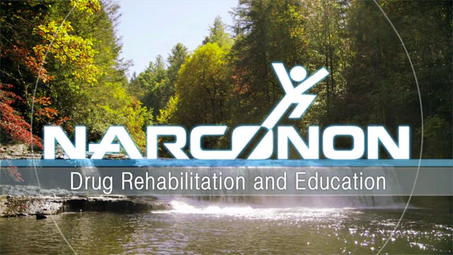DRUGS: WHAT YOU
NEED TO KNOW Booklet

Signs and Symptoms of Prescription Drug Abuse
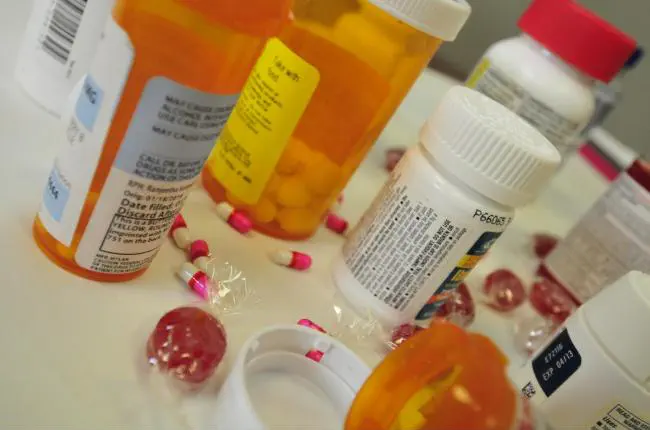
Courtesy of GAO.gov
Because abused prescription drugs range from powerful opioids to strong stimulants, the signs of abuse or misuse of these drugs will vary. While Europe has nowhere near the prescription drug abuse problem that the United States does, abuse of these drugs has been increasing for several years. It becomes even more important that families and medical practitioners identify the signs of addiction to these drugs so they can get their loved ones the help they need to regain sobriety.
Opioids
The class of prescribed opioid drugs includes: 1
- Propoxyphene
- Hydrocodone
- Dihydrocodeine
- Buprenorphine
- Morphine
- Oxycodone
- Methadone
- Fentanyl
- Hydromorphone
- Pethidine
One of the most popular painkillers has been oxycodone, the drug that initiated catastrophic levels of addiction and overdose deaths in the U.S. In this chart, you can see the moderate rise in the prescribing of oxycodone in Europe and compare it to the astronomical rise in the U.S.2
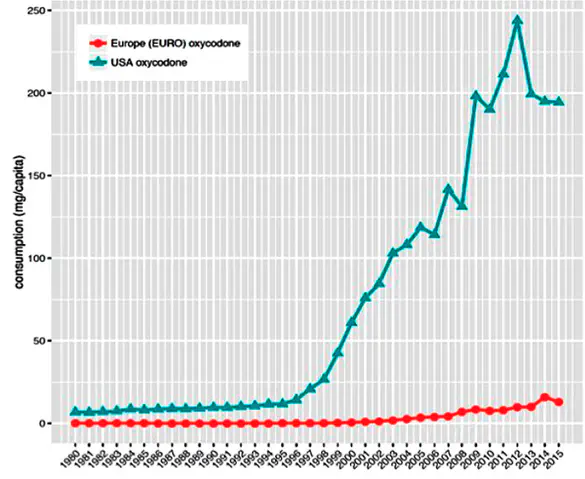
Courtesy of rimed.org (Rhode Island Medical Journal)
Symptoms of opioid abuse include: 3
- Slow pulse
- Slowed breathing
- Low body temperature
- Sedation
- Doping off
- Euphoria
- Pain relief
According to the World Health Organization, you should look for these signs of opioid overdose: 4
- Tiny, pinpoint pupils
- Unconsciousness
- Difficulty breathing which could include snoring or gasping
- Blue skin or dark lips search overdose5
- Inability to talk
Stimulants
This class of drug includes pharmaceutical forms of amphetamine and methamphetamine plus drugs prescribed for obesity, narcolepsy or study difficulties resulting from problems focusing.6
Symptoms include:
- Increased alertness
- Euphoria
- Excitement
- Heightened energy
- Reduced appetite
- Less need for sleep
- Sharpness of concentration
- Enlarged pupils
- Nausea
However, repeated administration of dopamine-increasing stimulants can result in psychotic symptoms and recurrent psychotic episodes in chronic users. Repeated use can also result in anxiety, irritability, restlessness, aggressiveness and paranoia.
Cardiovascular collapse, arterial damage, seizures, or overheating, resulting in organ breakdown may result in overdose death.
Sedatives and Tranquilizers
Sedatives being misused could include: 7
- Brotizolam (Lendormin)
- Flunitrazepam (Rohypnol)
- Loprazolam (Dormocot)
- Midazolam (Versed)
- Nitrazepam (Erinin)
- Temazepam (Normison)
- Alprazolam (Xanax)
- Chlordiazepoxide (Librium)
- Diazepam (Valium)
- Lorazepam (Ativan)
- Secobarbital8
- Amobarbital
- Butalbital
- Pentobarbital
- Sedation
- Reduced anxiety
- Dizziness
- Poor concentration
- Impaired memory
- Slowed heart rate
- Confusion
- Lowered blood pressure
Sedatives and tranquillizers are frequently abused in combination with other drugs. Testing of syringes discarded in several major cities found that in more than half the tests, the residue included a combination of drugs.10 The most common combination of drugs was a stimulant and an opioid, with benzodiazepines (a class of anti-anxiety drugs) being found in many of the syringes that also contained an opioid.
When sedatives or tranquillizers are combined with alcohol or opioids, there is an increased risk of respiratory shutdown resulting in death.9
A Special Comment about Fentanyl
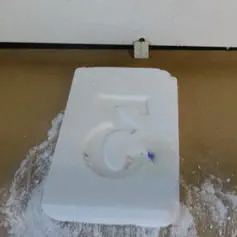
Courtesy of DEA.gov
Fentanyl is an intensely powerful synthetic opioid. In the United States, it was long used only for exceptionally severe cases of pain, such as cancer or terminal illness. So for many years, the abuse of this drug was solely connected with the misuse of medical supplies. Then drug traffickers realized they could profit greatly by manufacturing this drug in illicit labs.
The number of fatal overdoses began to soar in 2014 as more fentanyl began to be manufactured in illicit labs and then trafficked from foreign countries into the U.S.11
There are dozens of drugs in the fentanyl family, including sufentanil, alfentanil, mefentanyl and one of the strongest and most deadly drugs in the world, carfentanil.12
While EU nations have not suffered from this problem to the same extent, the impact of synthetic opioids is growing. According to the European Monitoring Center for Drugs and Drug Addiction (EMCDDA), 49 new synthetic opioids have been detected since 2009.10 Thirty-four of these were from the fentanyl family. Six new forms of fentanyl were reported for the first time in 2018 which reveals the expansion of this market.
Fake Prescription Drugs
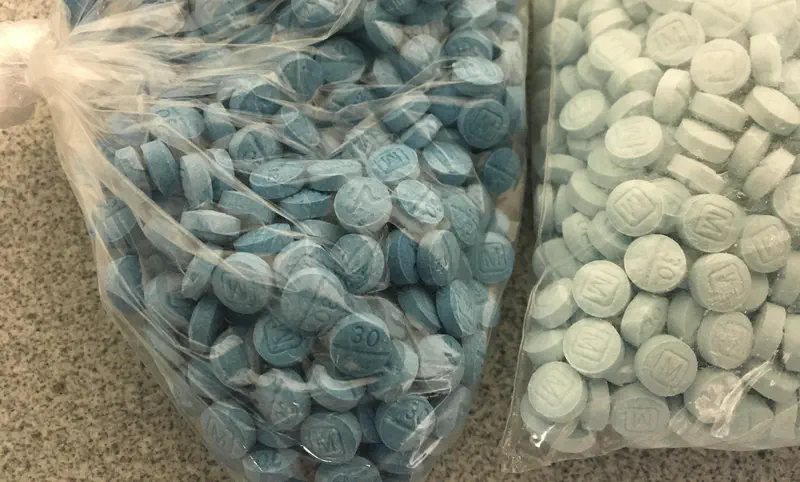
Courtesy of DEA.gov
In every country, the distribution of fake pills is a severe problem. It only takes the acquisition of powdered drugs from an international supplier, coloring agents, fillers and a pill press to go into this business. Counterfeit benzodiazepines such as alprazolam and diazepam are popular among drug traffickers and illicit online pharmacies.10
The risks are high for a person who decides to invest in these pills. These counterfeit pills could contain ingredients of bad or fatally toxic quality.13 This problem exists for people seeking drugs to abuse as well as those seeking a better price on their prescribed medications.
Prescription Drug Abuse by Nation
Here are notable figures on the annual prevalence of prescription drug abuse available from the United Nations Office on Drugs and Crime (not all countries had these figures available).14
- Austria: Tranquilizer misuse 8.9%
- Czechia: Tranquilizer misuse 19.5%; Prescription opioids misuse 2.6%
- Finland: Tranquilizer misuse 1.8%; Prescription opioids misuse .7%
- Germany: Tranquilizer misuse 5.4%; Prescription opioids misuse .3%
- Hungary: Tranquilizer misuse 9.52%
- Italy: Tranquilizer misuse 13.8%; Prescription opioids misuse .45%
- Netherlands: Tranquilizer misuse 10.5%
- Norway: Tranquilizer misuse 4.3%
- Portugal: Tranquilizer misuse .6%
- Spain: Tranquilizer misuse 2.3%
- Sweden: Tranquilizer misuse 2.78%
One stimulant has crossed over from licit to illicit distribution. Captagon was originally a prescription stimulant (fenetylline) but the drug was retired from the market.15 Illicit drug manufacturers took over the name and began distributing pills they called Captagon that most commonly contained amphetamine. There are still several types of amphetamine available by prescription.
The following chart shows a sampling of the lifetime prevalence of abuse of these classes of drugs: 16
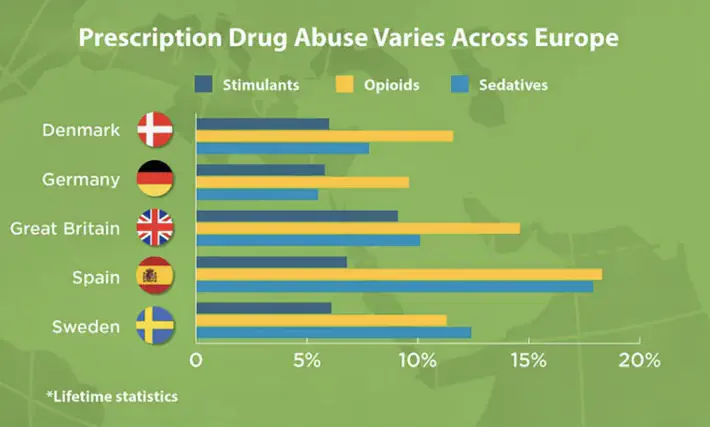
Courtesy of rti.org
Drugs and Violent Crime
One report from the EMCDDA gathered statistics from several countries to determine the proportion of people committing homicide who were also under the influence of drugs at the time.17
- Finland: 19%
- Sweden: 21%
- Denmark: 25%
- Norway: 28%
Additionally, 30% of perpetrators in Finland and 37% of those in Sweden were described as drug-dependent. It is easy to guess that if one could magically eliminate drug abuse of prescription or illicit drugs, the number of homicides might fall by these percentages.
Sources:
-
N. I. Cherny, et al.; Anals of Oncology “Formulary availability and regulatory barriers to accessibility of opioids for cancer pain in Europe: a report from the ESMO/EAPC Opioid Policy Initiative” Anals of Oncology ↩︎
-
Aiden Meyer, et al.; Rhode Island Medical Society (2020), “Prescription Opioid Prescribing in Western Europe and the United States” Rhode Island Medical Journal Contribution (PDF) ↩︎
-
NCBI, “Figure 4-4: Signs and Symptoms of Opioid Intoxication and Withdrawal” NCBI Aarticle ↩︎
-
World Health Organization (2021), “Opioid overdose” WHO Article ↩︎
-
American Society of Anesthesiologists, “Opioid Abuse” ASA Article ↩︎
-
United Nations Office on Drugs and Crime, “Treatment of stimulant use disorders: current practices and promising perspectives” UNODC Publication (PDF) ↩︎
-
Michael F. Weaver, MD; US National Library of Medicine National Institutes of Health—PMC (2015), “Prescription Sedative Misuse and Abuse” Yale Journal of Biology and Medicine Article ↩︎
-
United Nations Office on Drugs and Crime (2011), “The non-medical use of prescription drugs Policy direction issues DISCUSSION PAPER” UNODC Discussion Paper (PDF) ↩︎
-
National Institute on Drug Abuse (2011), “Commonly Abused Prescription Drugs” NIDA Publication ↩︎ ↩︎
-
European Monitoring Centre for Drugs and Drug Addiction (2019), “European Drug Report Trends and Development” EMCDDA Article (PDF) ↩︎ ↩︎ ↩︎
-
Centers for Disease Control and Prevention (2017), “Drug Overdose Deaths in the United States, 1999–2016” CDC Brief No. 294 ↩︎
-
Ruben S Vardanyan and Victor J Hruby US National Library of Medicine National Institutes of Health—PMC (2014), “Fentanyl-related compounds and derivatives: current status and future prospects for pharmaceutical applications” HHS Public Access Author Manuscript ↩︎
-
European Medicines Agency, “Falsified medicines: overview” EMA Article ↩︎
-
United Nations Office of Drugs and Crime, “Country List” UNODC Country List ↩︎
-
European Monitoring Centre for Drugs and Drug Addiction (2018), “Captagon: understanding today’s illicit market” EMCDDA Papers (PDF) ↩︎
-
RTI International, “Infographic: Prescription Drug Abuse in Europe” RTI Infographic ↩︎
-
European Monitoring Centre for Drugs and Drug Addiction (2020), “TECHNICAL REPORT Drug-related homicide in Europe: data protocol” EMCDDA Technical Report (PDF) ↩︎

 ®
®
